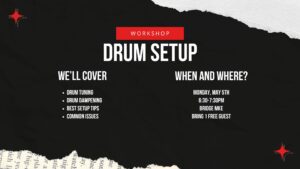While the upright piano is not always the instrument of choice these days, that doesn’t mean there aren’t people who prefer it. Some people want the real thing and that’s totally understandable. It’s not uncommon to see people straight up giving their upright pianos away for free on facebook marketplace. However, there are some tradeoffs to having the real thing. Maintenance is much more of a factor for the acoustic instrument. In this post, we’ll go over some of the basics you should know and watch out for on your acoustic piano.
1. Tuning
Making sure your piano is tuned is quite important. Pianos will naturally come untuned over time even if they never actually get used. They will especially come out of tune if you just moved them. If you just got a piano and moved it into your house, consider having a professional come over and tune it right away.
Piano tuning averages between $100 to $120 depending on the provider. You should consider having your piano tuned once every year or two. If you are purchasing an old piano that has had more than five years between tunings, you may consider getting that second tuning sooner rather than later. Your piano tech may not be able to get it perfectly in tune right away as the string tension changes will cause the wood to shift a lot after the first tuning.

When we got our first upright, it was a very old piano that hadn’t been tuned in over 30 years. We had it tuned right away and then proceeded to get a second tuning about six months later. You may need to do something similar if you receive a piano like that.
2. Cleaning
If you’re like me, you love a clean looking instrument. Keeping your piano clean both on the inside and outside can be important. What you use to clean your piano can vary quite a bit depending on the type of finish. No matter what you choose to clean your piano with, I recommend having a microfiber cloth on hand as well as a duster and a vacuum cleaner with a gentle brush attachment.
On the outside, you’ll want to avoid items with lemon oil in them. You can use windex for the exterior and hydrogen-peroxide for the keys themselves. On the inside, you’ll want to avoid using sprays and try to loosen the dirt first with a duster or microfiber cloth and then follow it up with the vacuum cleaner. While you can always pay someone to do this job, I recommend learning how to do it yourself. Once you understand the basics, it’s quite easy.
I found a very detailed video below on this topic that I highly recommend watching if you want to make sure your piano gets the best treatment possible.
3. Humidity Control
Living in the Midwest, we know that the seasons bring extreme changes in temperature and humidity. As the humidity in our houses change, this can effect the wood and life of our piano. Installing a humidity control system can help with this. If you are very aware of the humidity in your house and run large humidifiers during the winter months when the heating system dries things up, you may not have any need for this. If your house runs very dry during winter, you may consider taking steps to control the humidity around your piano.
Running a small scale humidifier in the room your piano lives in will help it keep in a consistent environment. If you have a very nice piano or are very particular about it, you may decide to install a humidity control system inside your piano. While this takes all the guess work out of handling the humidity, it does come at a cost and can range in price depending the quality of the system you have installed. If you own an upright piano, expect to pay around $500 for one of these systems. If you have a grand piano, expect to pay more.
4. Regulation Adjustment
Regulation is the adjustment of mechanical aspects, the hammers in the piano, and the cloth on the hammers. As you continue to play the piano, parts will begin to wear down and become less responsive. A skilled piano player will notice that the parts do not respond as well to your fingers as the should and will become especially noticeable on very quiet sections where a delicate touch is required.
Piano regulation may not be for everyone and is probably best reserved for very skilled players who will notice the difference as well as very nice quality pianos. Regulation is a very time consuming task and may cost around $500 depending on the service provider.
5. Voicing
Voicing is the manipulation of the felts on the hammer to change the tone of the strings. By using a pin or hard point, a tech can soften up the felts on a hammer. You might find that over years of playing, you favor certain notes/keys and this causes the piano to have a different tone depending on where you play on the piano. Having a voicing done can give you a more consistent tone across the piano.
Voicing a piano can cost anywhere from $100 to $200. This service is by no means mandatory but will be very important to the piano player with a keen ear.

6. Restring
The strings is the life of the piano. It’s tone, vibrancy, volume, and response are all dependent on the life and quality of the strings that ring inside it. So it comes as no surprise that when the strings start to lose their luster or their tuning stability, they will eventually need to be replaced. There are wide varying claims on how often a string replacement needs to happen. Many techs will tell you that you need to replace your strings every two to five years. That might not seem very often but when you realize the cost could be as much as $1200 you start to rethink things a little.
How often you choose to restring a piano is ultimately up to you. However, I would recommend that you consider restringing the piano around the ten year mark. Some people never restring their pianos and they’re fine with that. However, strings will eventually where out and either become dull, dead, or even snap and break inside the piano and you’ll be forced to replace them.
Other Posts

Rhythm Guitar Mastery: Strumming and Riff Techniques for Pop and Country
You know that feeling when a song just clicks — when the beat feels like it’s syncing with your heartbeat, and the chords seem to

Home Recording on a Budget: Recording Your Practice Sessions
You’ve been working hard on your music—nailing that tricky chord change, perfecting your drum fills, polishing your vocals. But how do you really know if

Drum Setup Workshop
Drum Setup Workshop We are announcing our next upcoming workshop! Many drummers struggle with tuning and best setup practices. With so many variables and no